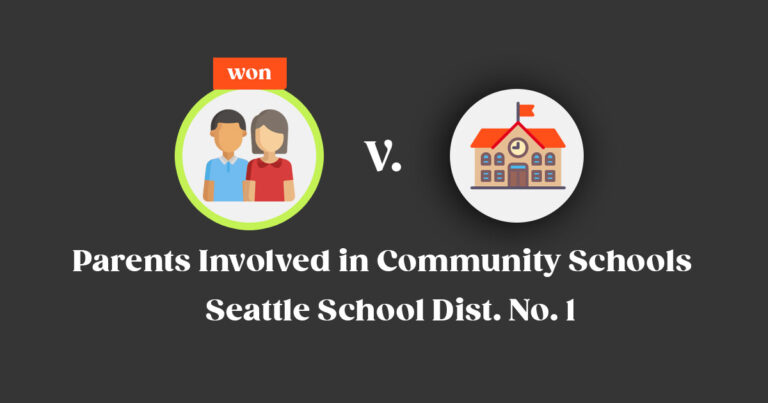Quick Summary
The Seattle School District had a tiebreaker system for admissions to high schools when too many students applied to the same school. Ethnicity was a factor in the tiebreaker, which ensured that the schools had a diverse student population.
Parents Involved in Community Schools filed a lawsuit against the district, alleging that the race-based tiebreaker was discriminatory and in violation of the Fourteenth Amendment’s Equal Protection Clause, the Civil Rights Act of 1964, and Washington state law.
The district court initially ruled in favor of the district, but the 9th Circuit Court of Appeals later reversed the decision. The U.S. Supreme Court granted certiorari.
The U.S. Supreme Court ruled that the Seattle School District’s race-based tiebreaker system for admissions to high schools was illegal under the Equal Protection Clause of the Fourteenth Amendment. The court applied a strict scrutiny methodology and found that the system was primarily aimed at achieving demographic goals rather than any clear educational benefit from racial diversity.
Rule of Law
It is unconstitutional for public schools to develop strategies that involve dividing students into classes based on their racial identity.
Facts of the Case
Students living in the Seattle School District could apply to any high school. Because there were only so many spots in each school, the district set up a tiebreaker admissions system.
If too many students applied to the same high school, there would be a series of tiebreakers used to decide who would get admission.
Ethnicity was the second most important factor in the tiebreaker because the district wanted to make sure the schools had people of all different races. This tiebreaker was used when a school’s racial makeup was different from the racial makeup of the public school population as a whole.
Applicants of the race who would bring the population closer to this balance were given priority.
On June 18, 2000, a group called Parents Involved in Community Schools sued the district. They claimed that the race-based tiebreaker was against the Fourteenth Amendment’s Equal Protection Clause, the Civil Rights Act of 1964, and Washington state law.
The district court discarded the case and said that the race-based tiebreaker was legal. In June 2005, the United States Court of Appeals for the 9th Circuit changed its mind. On June 5, 2006, the U.S. Supreme Court agreed to hear the case.
Issue
Is it a violation of the Equal Protection Clause to deny students admission to their preferred high school based on race in order to achieve racial balance?
Holding and Conclusion
Yes.
The court used a “strict scrutiny” methodology to find the district’s racial tiebreaker scheme illegal under the Fourteenth Amendment’s Equal Protection Clause. Chief Justice John Roberts stated in the plurality opinion, “The way to prohibit discrimination based on race is to cease discriminating based on race.”
The court determined that the district’s tiebreaker plan was primarily aimed toward demographic aims rather than any clear educational benefit from racial diversity. The district also failed to demonstrate that its goals could not have been achieved through non-racial means.
Justice Kennedy concurred with the judgment in a separate opinion, agreeing that the district’s use of race was unconstitutional but emphasizing that public schools may sometimes consider race to guarantee equitable educational opportunity.
Reasoning and Analysis
On June 28, 2007, the Supreme Court ruled that the tiebreaker proposal violated the Constitution. The majority of individuals believed that the practice of separating students into two groups without taking their individual needs into account did not fulfill the stringent scrutiny required for considering race when accepting pupils.
Even though the majority acknowledged that the Supreme Court had previously determined that racial diversity was a compelling government interest, it stated that the facts of this case meant that the Grutter v. Bollinger judgment did not apply.
Those who disagreed asserted that the majority opinion did not take the case’s circumstances into account. They also stated that the majority of individuals believed “Announces new guidelines that will make it more difficult for state and local governments to effectively address the growing segregation of public schools. It could result in several lawsuits based on race, which would make the situation even worse than it is now. It undermines Brown’s commitment to merging elementary and secondary education, which local communities have been attempting to do.”
According to the schools, these ratios improve exam performance, provide objective measurements, and facilitate student interaction. But even though these are included in the plans, they are not the primary objectives; hence they are insufficient.
Relevant FAQs of this case
References
Was this case brief helpful?
